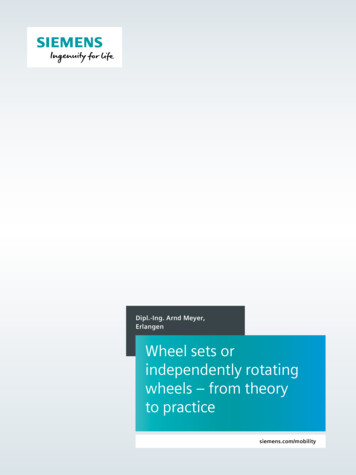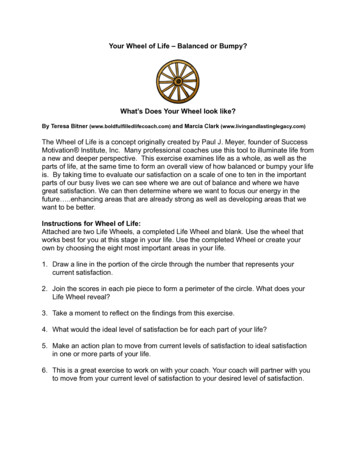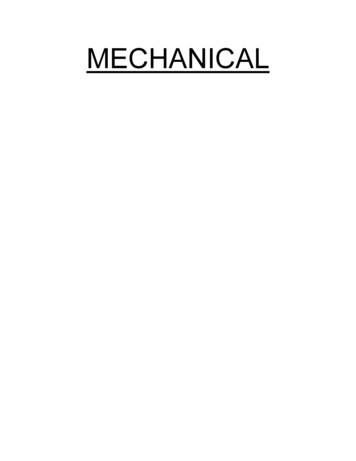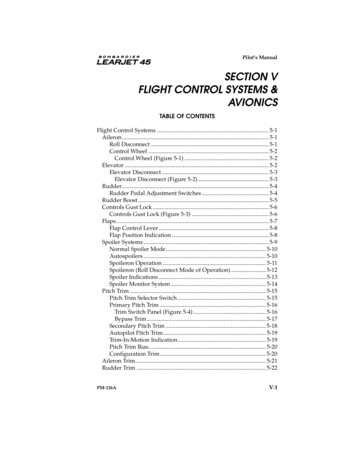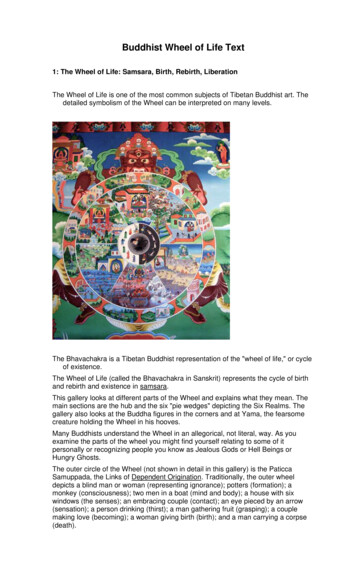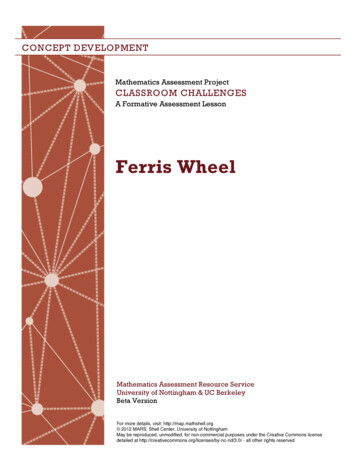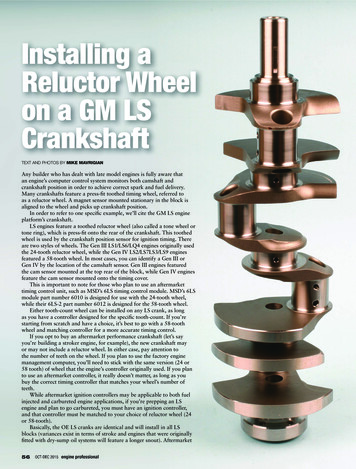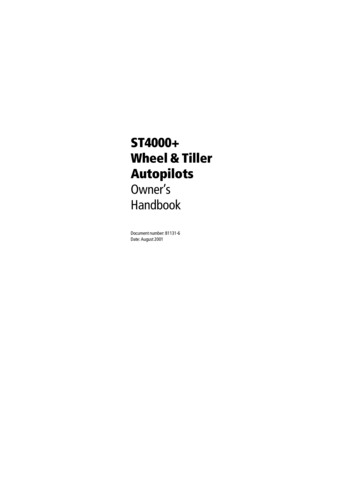
Transcription
ST4000 Wheel & TillerAutopilotsOwner’sHandbookDocument number: 81131-6Date: August 2001
iiST4000 Wheel & Tiller Autopilots: Owner’s HandbookAutohelm, HSB (High Speed Bus), SailPilot, SeaTalk and SportPilotare registered trademarks of Raymarine Ltd.Raymarine, AST (Advanced Steering Technology), AutoAdapt,AutoLearn, AutoRelease, AutoSeastate, AutoTack, AutoTrim,FastTrim, GyroPlus, RayGyro, RayPilot and WindTrim aretrademarks of Raymarine Ltd.Handbook contents Raymarine Ltd 2001.
PrefaceiiiST4000 autopilot system layoutWheel driveORTiller driveBoat's electricaldistribution panelFluxgate compassST4000 control unitRudder position sensor(optional fit for wheel pilot only)SeaTalk instrumentNMEAinstrumentor navigatorD5332-1
ivST4000 Wheel & Tiller Autopilots: Owner’s Handbook
PrefacevContentsAbout this handbook .ixImportant Information .xWarranty . xSafety notices . xEMC conformance .xiHandbook information . xiChapter 1: Introduction .11.1 Features . 11.2 Extended systems . 2Chapter 2: Basic Operation .32.1 Using the control unit . 4Key functions . 4Display layout . 52.2 Using Auto mode . 6Engaging the autopilot (Auto mode) . 6Disengaging the autopilot (Standby mode) . 7Changing course in Auto mode . 8Dodging obstacles in Auto mode . 8Returning to the previous locked heading (LAST HDG) . 9Automatic tack (AutoTack) . 10Making major course changes . 10Gusting conditions . 112.3 Adjusting autopilot performance . 12Changing the response level (AutoSeastate) . 12Changing the rudder gain . 132.4 Autopilot alarms . 14Responding to alarms . 142.5 Adjusting display and keypad lighting . 18Chapter 3: Advanced Operation .193.1 Using Track mode . 20Selecting Track mode . 20Exiting Track mode . 22Cross track error . 22Tidal stream compensation . 23Waypoint arrival and advance . 24Dodges in Track mode . 25Safety in Track mode . 25
viST4000 Wheel & Tiller Autopilots: Owner’s Handbook3.2 Using Wind Vane mode . 27Selecting Wind Vane mode . 27Exiting Wind Vane mode . 28Adjusting the locked wind angle . 28Returning to the previous apparent wind angle(LAST WND) . 28Dodges in Wind Vane mode . 29Wind shift alarm . 29Using AutoTack in Wind Vane mode . 30Operating hints for Wind Vane mode . 303.3 Displaying data pages . 31Chapter 4: Maintenance & Fault Finding .334.1 Fault finding . 344.2 General maintenance . 36Wheel drive . 36Control unit . 38EMC advice . 394.3 Product support . 40Software version . 40Chapter 5: Installing the ST4000 .435.1 Planning the installation . 44Tools required . 44EMC installation guidelines . 465.2 Control unit . 48Location . 48Mounting procedure . 49Cable connectors . 51Power supply connection . 51SeaTalk connections . 52NMEA connections . 535.3 Fluxgate compass . 55Location . 55Mounting . 57Connecting to the control unit . 585.4 Tiller drive (tiller pilots only) . 59Critical dimensions . 59Basic installation . 60Installation accessories . 61Connecting to the control unit . 68
Prefacevii5.5 Wheel drive (wheel pilots only) . 70Installation stages . 70Drilling the spoke clamp holes . 71Securing the wheel drive to the wheel . 74Attaching the pedestal bracket . 75Connecting to the control unit . 795.6 Rudder position sensor (wheel pilot option) . 81Ensuring correct alignment . 81Securing the sensor to the boat . 83Attaching the sensor to the tiller arm . 83Checking alignment . 84Connecting to the control unit . 84Chapter 6: Setting-up the ST4000 .856.1 Functional test . 86Switch on . 86Autopilot steering direction . 86Checking connections . 886.2 Check rudder sensor operation (if fitted) . 906.3 Initial sea trial . 91Overview . 91Correcting the compass deviation . 92Adjusting the heading alignment . 95Checking autopilot operation . 95Checking the rudder gain . 966.4 Autopilot calibration techniques . 98Step 1 - Switch on ancillary equipment . 98Step 2 - Apply initial settings . 98Step 3 - Adjust the rudder damping . 99Step 4 - Adjust the rudder gain . 99Step 5 - Adjust the AutoTrim setting . 99Step 6 - Further adjustments . 99Chapter 7: Customizing the ST4000 .1017.1 User setup . 102Compass deviation correction (SWING COMPASS) . 102Deviation display (DEVIATION) . 102Heading alignment (ALIGN HDG) . 102Heading mode (HDG MAG/TRU) . 102Bar selection (RUDD BAR/STEER BAR/NO BAR) . 104Data pages 1-7 (DATA PAGE) . 104
viiiST4000 Wheel & Tiller Autopilots: Owner’s Handbook7.2 Dealer setup . 106Calibration lock (CAL LOCK) . 108Pilot type (4000 WHL/TILL) . 108Rudder gain (RUDD GAIN) . 108Response level (RESPONSE) . 108Turn limit (TURN RATE) . 108Rudder alignment (ALIGN RUD) . 108Rudder limit (RUD LIMIT) . 109Off course alarm (OFF COURSE) . 109AutoTack angle (AUTOTACK) . 109AutoTrim (AUTOTRIM) . 110Drive type (DRIVE TYP) . 110Magnetic variation (VARIATION) . 110AutoAdapt (AUTOADAPT) .111Latitude (LATITUDE) .111Rudder damping (RUDD DAMP) . 112Cruise speed (CRUISE SP) . 112Specifications . 113Glossary . 115Index . 117
PrefaceixAbout this handbookWelcome to the handbook for the ST4000 wheel and tillerautopilot systems. This handbook contains two main parts:Part 1: Using the ST4000 Autopilot1Chapter 1: IntroductionIntroduces the autopilot, its features and its use.page 12Chapter 2: Basic OperationCovers basic autopilot operation: using Auto mode,interpreting alarms, adjusting autopilot performance andchanging the control unit lighting.page 33Chapter 3: Advanced OperationExplains how to use Track and Wind Vane modes, anddisplay data pages.page 194Chapter 4: Maintenance & Fault FindingProvides general maintenance procedures andinformation to help you resolve problems you mayencounter with the autopilotpage 33Part 2: Installing the ST4000 Autopilot5Chapter 5: Installing the ST4000 Explains how to install your autopilot and its components.page 436Chapter 6: Setting-up the ST4000 Covers functional testing and dockside procedures afterinstallation, and initial sea trials.page 857Chapter 7: Customizing the ST4000 Provides details on adjusting the autopilot settings to suityour boat.page 101At the end of this handbook we have included productspecifications, a glossary and index, and templates for installingdifferent parts of the system.Note: This handbook contains important information aboutinstalling, using and maintaining your new Raymarine product. Toget the best from the product, please read this handbook thoroughly.
xST4000 Wheel & Tiller Autopilots: Owner’s HandbookImportant InformationWarrantyTo register your new Raymarine product, please take a few minutes tofill out the warranty card. It is important that you complete the ownerinformation and return the card to us to receive full warranty benefits.Safety noticesWARNING:Product installationThis equipment must be installed and operated in accordancewith the instructions contained in this handbook. Failure to do socould result in poor product performance, personal injuryand/or damage to your boat.WARNING:Electrical safetyMake sure the power supply is switched off before you make anyelectrical connections.WARNING:CalibrationWe supply this product calibrated to default settings that shouldprovide stable performance for most boats. To ensure optimumperformance on your boat, you must complete Chapter 6:Setting-up the ST4000 before use.WARNING:Navigation aidAlthough we have designed this product to be accurate andreliable, many factors can affect its performance. As a result, itshould only be used as an aid to navigation and should neverreplace common sense and navigational judgement. Alwaysmaintain a permanent watch so you can respond to situations asthey develop.Your Raymarine autopilot will add a new dimension to your boatingenjoyment. However, it is the skipper’s responsibility to ensure thesafety of the boat at all times by following these basic rules: Ensure that someone is present at the helm AT ALL TIMES, totake manual control in an emergency.
Prefacexi Make sure that all members of crew know how to disengage theautopilot.Regularly check for other boats and any obstacles to navigation –no matter how clear the sea may appear, a dangerous situation candevelop rapidly.Maintain an accurate record of the boat’s position by using eithera navigation aid or visual bearings.Maintain a continuous plot of your boat’s position on a currentchart. Ensure that the locked autopilot heading will steer the boatclear of all obstacles. Make proper allowance for tidal set – theautopilot cannot.Even when your autopilot is locked onto the desired track using anavigation aid, always maintain a log and make regular positionalplots. Navigation signals can produce significant errors undersome circumstances and the autopilot will not be able to detectthese errors.EMC conformanceAll Raymarine equipment and accessories are designed to the bestindustry standards for use in the recreational marine environment.The design and manufacture of Raymarine equipment andaccessories conform to the appropriate ElectromagneticCompatibility (EMC) standards, but correct installation is required toensure that performance is not compromised.Handbook informationTo the best of our knowledge, the information in this handbook wascorrect when it went to press. However, Raymarine cannot acceptliability for any inaccuracies or omissions it may contain. In addition,our policy of continuous product improvement may changespecifications without notice. As a result, Raymarine cannot acceptliability for any differences between the product and the handbook.
xiiST4000 Wheel & Tiller Autopilots: Owner’s Handbook
Part 1: Using the ST4000 Part 1:Using theST4000
Part 1: Using the ST4000
Chapter 1: Introduction1Chapter 1: Introduction1 IntroductionD5460-11.1 FeaturesThe Raymarine ST4000 Plus (ST4000 ) is a SeaTalk compatibleautopilot available in versions suitable for boats with either tiller orwheel steering systems. This autopilot system will steer your boat toa heading automatically, accurately and reliably.The ST4000 has four main operating modes:1. Standby: autopilot off (see page 7)2. Auto: autopilot engaged and locked onto a heading (see page 6)3. Track: autopilot engaged and maintaining a track between twowaypoints created using a navigation system (see page 20)4. Wind Vane: autopilot engaged and maintaining a course relativeto an apparent wind angle (see page 27)The ST4000 also provides the following features: automatic tack facility (AutoTack) in Auto and Wind Vane modesautomatic compass deviation correctionNortherly/Southerly heading compensationautomatic heading deadband – seastate controlwaypoint advance featuresetup and calibration options to optimize performance on your boat
2ST4000 Wheel & Tiller Autopilots: Owner’s Handbook1 Introduction1.2 Extended systemsThe ST4000 is compatible with all other SeaTalk instruments.You can connect it to additional fixed or handheld SeaTalk autopilotcontrol units located at secondary steering and control positions(see page 52).You can also use the ST4000 autopilot with any navigator(GPS, Decca, Loran) or wind instrument that transmits data in theinternationally-accepted National Marine Electronics Association(NMEA) 0183 format.The ST4000 can display SeaTalk and NMEA instrument data in auser-defined selection of data pages. When you are using theST4000 to repeat instrument data, it shows a ‘pop-up’ pilot page for5 seconds whenever you make a change in autopilot control.The ST4000 can share all data transmitted from SeaTalkinstruments: it can use wind information from a SeaTalk wind instrument forwind trim steering in Wind Vane mode without the need for aseparate vaneit can use track information from a SeaTalk navigation instrumentto provide waypoint control in Track modeit can use boat speed from a SeaTalk speed instrument to optimizetrack-keeping performanceRudder position sensor (wheel drives only)On wheel drive systems you can fit a rudder position sensor toimprove the wheel pilot’s performance (see page 81). This isparticularly advisable if your boat’s steering system has significantbacklash, or you require optimum performance from a mechanical orcable steering system. By using the information from the rudder anglesensor, the ST4000 will also be able to show the true rudder angle inStandby and Auto modes.Note: You MUST add a rudder position sensor if fitting the ST4000 to a hydraulic steering system.
Chapter 2: Basic Operation3Chapter 2: Basic OperationThe sections in this chapter explain how to use the basic functions onyour autopilot:Using the control unitSummarizes the key functions and screen layout on theST4000 control unit.page 42.2Using Auto modeProvides instructions for engaging/disengaging theautopilot and using Auto mode.page 62.3Adjusting autopilot performanceMaking temporary adjustments to response level andrudder gain to enhance autopilot performance.page 122.4Autopilot alarmsDescribes how to recognize and respond to theautopilot alarms.page 142.5Adjusting display and keypad lightingExplains how to change the lighting on the control unitdisplay and keypad.page 18CAUTION: Important note for wheel drive systemsAfter each trip, flush inside the drive unit by inserting a hose pipein the free slot on the back cover. This will prevent any build-up ofsalt on the drive ring and bearings.2 Basic Operation2.1
4ST4000 Wheel & Tiller Autopilots: Owner’s Handbook2.1 Using the control unitKey functions 2 Basic Operation The autopilot always powers up in Standby mode.You control the autopilot by pressing the buttons on the controlunit. The control unit confirms each button press with a shortbeep.You access the main functions by pressing a single key: for example, when the autopilot is operating you can makecourse changes using the -1, 1, -10 and 10 keysTo access other functions you need to press two keys together: for example, when the autopilot is operating you make anAutoTack to port by pressing the -1 and -10 keys togetherYou can return to manual steering at any time by pressingstandby and disengaging the autopilot (see page 7).-1 plus -10Press togetherfor AutoTackto port-1 plus 1Press for Response levelPress for 1 secondfor Rudder GainTRACKPress for Trackmode from AutoPress to acceptwaypoint advancePress for 1 secondto skip waypointDISPPress forData PagePress for 1 secondfor lamp controlSTANDBYPress forStandby modePress and hold forUser and Dealersetup modes 1 plus 10Press togetherfor AutoTackto starboardCourse change keysPort 1 Starboard 1 Port 10 Starboard 10 AUTOPress for Auto modePress for 1 secondfor Last HeadingPress again toaccept Last HeadingSTANDBY plus AUTOPress for Wind Vane modePress for 1 second for Last WindPress again to accept Last WindD3447-2
Chapter 2: Basic Operation5Display layoutThe ST4000 autopilot display provides the following information:Variable text region (up to 9 characters/digits)Heading indicatorsDistance unitsResponse level indicator2 Basic OperationAutopilot modeindicatorsPort and Starboarddirection-to-steerindicatorsCalibration modeindicatorRudder or Steer direction indicator(bar graph in 2 increments) D3316-2If the display shows no distance unit all distances are inkilometres (Km), otherwise distances are in nautical miles (nm)or statute/land miles (SM).The bar graph at the bottom of the screen is normally adirection-to-steer indicator (you can change this in User setup,see page 104). The information displayed on the bar graph variesaccording to the autopilot mode:Autopilot modeInformation displayed on bar graphStandbyRudder bar (only if a rudder position sensor is fitted)AutoHeading error barTrackCross track error (XTE) bar, in 0.02 nm incrementsWind VaneWind angle error bar
6ST4000 Wheel & Tiller Autopilots: Owner’s Handbook2.2 Using Auto modeEngaging the autopilot (Auto mode)1. Steady the boat on the required heading.2. Wheel Pilot: Engage the wheel drive clutch by rotating the clutchlever clockwise (so the lever engages fully onto the locating pip).Tiller Pilot: Place the pushrod end over the tiller pin. If necessary,extend or retract the pushrod using the -1, 1, -10 and 10 keys.WARNING: Wheel drive clutchAlways reach AROUND (not through) the wheel to operate thewheel drive clutch lever.2 Basic Operation.Wheel pilotEngage the clutchon the wheel pilotTiller pilotabUse these keys toextend or retract the pushrodD5341-13. Press auto: in Auto mode, the display shows the locked autopilot headingD3560-2
Chapter 2: Basic Operation7CAUTION:Autopilot course control makes it easier to sail a boat, but it isNOT a substitute for good seamanship. ALWAYS maintain apermanent watch, no matter how clear the sea appears to be.Disengaging the autopilot (Standby mode)1. Press standby. in Standby mode, the display shows the boat’s currentcompass heading.CAUTION: Wheel drive systemsOn wheel drive systems, always make sure that the clutch isFULLY DISENGAGED before you leave the boat.2 Basic OperationD3561-22. Disengage the autopilot to return to hand steering: Wheel Pilot: Disengage the wheel drive clutch by rotating theclutch lever anti-clockwise (so the lever engages fully ontothe locating pip). Tiller Pilot: Remove the drive unit from the tiller pin. Ifrequired, retract the push rod using -1, 1, -10 and 10 keys.3. The last heading is memorized and can be recalled (see page 9).
8ST4000 Wheel & Tiller Autopilots: Owner’s HandbookChanging course in Auto modeIn Auto mode, use the -1 and -10 (port) and 1 and 10 (starboard)keys to change the locked heading in steps of 1 or 10 . For example:press -10 three times for a 30 course change to port.2 Basic OperationPortStarboardororD3320-2Dodging obstacles in Auto modeTo avoid an obstacle when your boat is under autopilot control:1. Select a course change in the appropriate direction. For example,press -10 three times for a 30 dodge to port.ObstacleOriginalcourseDodgeD3303-22. When safely clear of the obstacle, you can either: reverse the previous course change (for example, press 10three times), or return to the previous locked heading (LAST HDG)
Chapter 2: Basic Operation9Returning to the previous locked heading (LAST HDG)If you have steered the boat away from the selected locked headingfor any reason (for example, executing a dodge maneuver or selectingStandby), you can return to the previous locked heading as follows:1. Press auto for 1 second. The display shows the previous lockedheading (LAST HDG?) for 7 seconds.SECOND2. To accept the previous heading, and resume this course, pressauto within this 7 second 31-1Note: If you do not press auto while the display is flashing, theautopilot will maintain the current heading.2 Basic OperationD3562-2Note: The direction-to-steer indicator shows the direction the boatwill turn.
10ST4000 Wheel & Tiller Autopilots: Owner’s HandbookAutomatic tack (AutoTack)The ST4000 has a built in automatic tack facility (AutoTack) thatturns the boat through a pre-determined angle in the requireddirection. The default AutoTack angle is 100 , but you can adjust thisin Dealer setup (see page 109). to AutoTack to port: press the -1 and -10 keys togetherto AutoTack to starboard: press the 1 and 10 keys togetherAutoTack - PortAutoTack - Starboard2 Basic Making major course changesCAUTION:Only make major course changes when steering MANUALLY.This ensures that the boat will safely clear any obstructions orother boats, and you can take into account the changed wind andsea conditions on the new heading before engaging the autopilot.Large course changes which change the apparent wind direction canproduce large trim changes. When a sudden trim change occurs (forexample due to weather helm or sail imbalance) there will be a delayof up to one minute before the automatic trim applies rudder to restorethe locked heading.In these situations, the autopilot will not immediately assume the newautomatic heading, and will only settle onto course when theautomatic trim has been fully established. To eliminate this problem,use the following procedure to make major course changes:
Chapter 2: Basic Operation111. Note the required new heading.2. Select standby for manual steering, so you can bring the boat tothe new heading MANUALLY.3. Select auto: allow the boat to settle onto course, then bring theboat to the final course in 1 steps using the -1 or 1 keysGusting conditionsIn gusting conditions, the course may tend to wander slightly,particularly if the sails are badly balanced. If you take the followingprecautions, the autopilot will be able to maintain competent controleven in gale force conditions: You can significantly improve course keeping by improving thesail balance: do not allow the boat to heel over excessively ease the mainsheet traveller to leeward to reduce heeling andweather helm if necessary, reef the mainsail a little earlyIn very strong winds and large seas, you should avoid sailing withthe wind dead astern: ideally, bring the wind at least 30 away from a dead run in severe conditions, you may also need to remove themainsail and sail under headsail only2 Basic Operation
12ST4000 Wheel & Tiller Autopilots: Owner’s Handbook2.3 Adjusting autopilot performanceDuring normal autopilot operation in any mode you can maketemporary adjustments to: response levelrudder gainNote: You will lose these temporary changes to response level andrudder gain whenever the system is powered off then on again. Youcan make permanent adjustments in Dealer setup (see page 108).2 Basic OperationChanging the response level (AutoSeastate)The response level controls the relationship between the autopilot’scourse keeping accuracy and the amount of helm/drive activity. Response Level 1: AutoSeastate on (Automatic deadband)This setting causes the autopilot to gradually ignore repetitiveboat movements and only react to true variations in course. Thisprovides the best compromise between power consumption andcourse keeping accuracy, and is the default calibration setting.Response Level 2: AutoSeastate off (Minimum deadband)This setting provides the tightest course keeping possible.However, tighter course keeping results in increased powerconsumption and drive unit activity.To make a temporary change to the response setting:1. Display the RESPONSE screen by pressing the -1 and 1 keystogether momentarily.D3310-4
Chapter 2: Basic Operation13Note: If you have set up the RESPONSE screen as a default data page(see page 104) you can also access it by pressing disp and thenscrolling through the data pages.2. Press -1 or 1 to change the response level.3. Press disp or wait for 5 seconds to return to the previous display.Changing
(GPS, Decca, Loran) or wind instrument that transmits data in the internationally-accepted National Marine Electronics Association (NMEA) 0183 format. The ST4000 can display SeaTalk and NMEA instrument data in a user-defined selection of data pages. When you are using the ST4000 to repeat instrument data, it shows a 'pop-up' pilot page for
